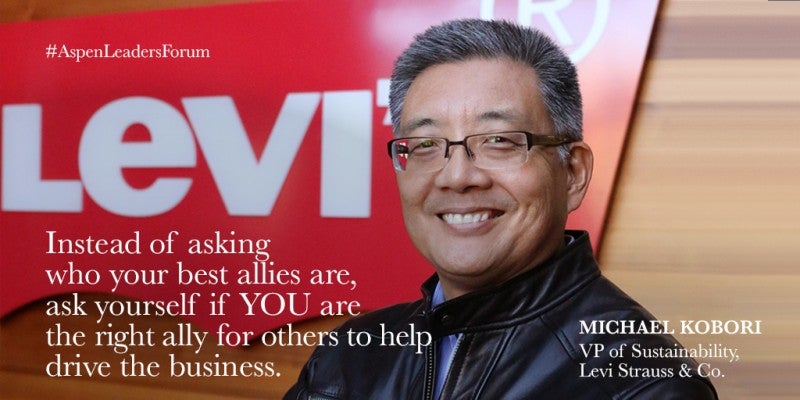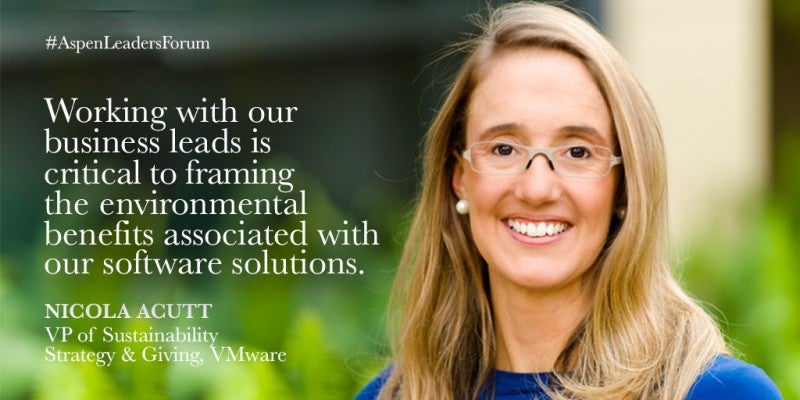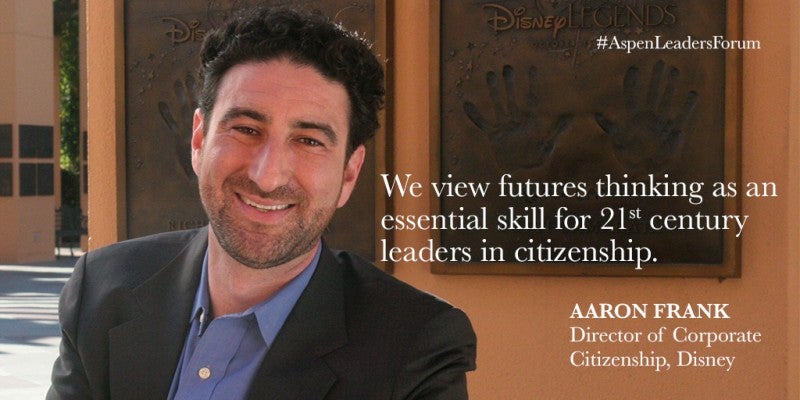Over the next two weeks, heads of state, dignitaries, and corporate executives will descend on Manhattan, New York, for the United Nations General Assembly meeting, the launch of the Sustainable Development Goals, the Clinton Global Initiative Annual Meeting, and the first ever visit from Pope Francis. Each of these events, at its core, focuses on creating better conditions for global society to thrive.
As the most powerful institution of our day, business, with its capacity to create social, environmental, and economic value for wider society, should listen closely and take notes as these events unfold. Fortunately, many global companies are already well on their way toward developing their own plans for aligning their business strategies with the common good. Below, we share insights from top sustainability strategists, each a member of the Aspen Institute Business & Society Leaders Forum, who are helping their companies move beyond incremental change — to addressing global social and environmental issues at a systems level.

1. Look for allies in unlikely places and become one yourself.
You can’t move the needle alone. The best sustainability strategists look for untapped resources and unlikely allies to help propel the sustainability agenda forward. As such, it is important to think deeply and strategically about which departments and individuals you might be able to work with in new and innovative ways.
Talya Bosch, vice president of internal communications and social ventures at Western Union, has a strong partnership with her human resources department. “At Western Union,” she said, “the degree to which an employee exhibits behaviors consistent with the company’s responsibility goals is a metric included in employee performance reviews.”
When Michael Kobori, vice president of sustainability at Levi Strauss & Co., needs to generate new approaches to marketing and selling sustainability, he looks to his e-commerce and retail colleagues who have become unexpected allies. “Colleagues in these functions are seeking new and innovative ways to engage consumers and we are able to create some exciting programs with them, including our clothing recycling initiative, which launched in all our US retail stores last month,” he said.
As important as it is to find allies, Kobori notes that it is also essential to be one yourself. “Instead of asking who your best allies are, ask yourself if you are the right ally for others to help drive the business,” he said. “Do you really understand pricing, supply chain, regulations, and compliance? Sometimes in order to close loops and build bridges, we first need to acquire more knowledge.”

2. Frame, re-frame, and frame again.
Be ready to tell your story 10 different ways to 10 different influencers. You will need them all on board in order to reach next stage corporate sustainability. What frame best explains the business imperative to each influencer? Is it operational efficiency, consumer demand, internal culture, resource availability, or disaster preparedness/resilience?
Nicola Acutt, vice president of global sustainability strategy and giving at VMware, connects sustainability to one of the company’s core technologies: virtualization software. “A key value proposition for the software has always been that it helps customers reduce costs because they can link several operating systems and applications to run on one physical server or ‘host,’” Acutt said. “Working with our business leads is critical to framing the environmental benefits associated with our software solutions in a way that is relevant and compelling to customers and partners.”
At the same time, Acutt also works closely with HR executives to connect her work with the company’s culture, values, and employee experience because “sustainability is a talent and employment brand differentiator.” As a result of using multiple frames to illustrate the value of sustainability, she has found business leaders across functions are enthusiastic to support the company’s sustainability strategy.

3. Recognize signals.
As a cross-functional leader within your company, you should begin to see yourself as an intelligence gatherer. Become an expert at synthesizing information and data from across your organization and picking up on signs and future trends. Take Mark Weick, director of sustainability at Dow: he believes “trendspotting” is an essential aspect of his job. “Sometimes we think an issue is just social or environmental… until it becomes an economic one,” he said. “Forecasting when the social or environmental issue will become economic — and developing products, services, and practices based on those signals — is key to advancing next-stage sustainability within your organization.”
“We view futures thinking as an essential skill for 21st century leaders in citizenship — after all, sustainability at its core is about creating a brighter future for the world,” said Aaron Frank, director of corporate citizenship at Disney. “We’ve built a team of practitioners within citizenship at Disney to focus on developing this skill. We invest in the team through focused trainings and applied learning opportunities. In turn, they dedicate time to identifying the latest trends that may affect our business and citizenship efforts.”
4. Be ready to act at a moment’s notice.
As an executive working within a large, complex organization — often with competing priorities and an infinite number of projects that need funding — you must be ready to pitch, frame, woo, and cajole at a moment’s notice. You never know when you might see an opportunity to strategically push your idea or program into the spotlight. Hesitate and the opportunity might disappear. That is why, as one Leaders Forum member said, “planned opportunism is key.”
5. Dare to challenge the culture.
Creating a culture that supports innovative, long-term value creation is mission critical to reaching next-stage corporate sustainability. “It goes beyond building a culture that allows people to be creative, celebrate success, and learn from failure,” said one Forum member. “When it comes to changing culture, you have to be constructively dissatisfied… With that stance you will avoid complacency and stay vigilant for opportunities to adapt and change.”
Although you can’t actually prototype culture itself, companies can prototype things like strategy, structure, process, and incentives to see if they lead to the desired behaviors in the organization.
Members of the Leaders Forum are thinking deeply about how to cultivate this culture within their companies. One critical lever is hiring and retaining employees that support this culture. In early 2016, the Business and Society Program plans to continue exploring how HR/talent practices contribute to a culture that supports next-stage corporate sustainability. Stay tuned and visit the Leaders Forum webpages for more information.
Voices is a periodic series reflecting the expertise of the Aspen Institute Business & Society Leaders Forum. The Forum, created in 2012, is a working platform for senior sustainability executives.
Paige Soffen is senior program associate at the Aspen Institute Business and Society Program (BSP). Trisha King is program coordinator at BSP.

